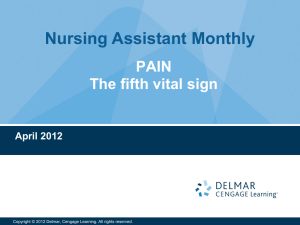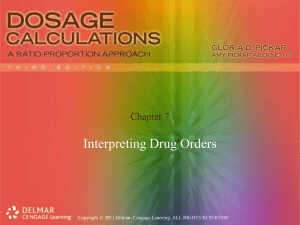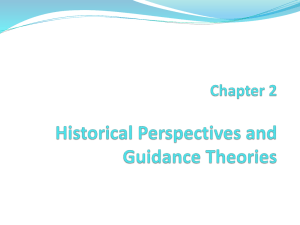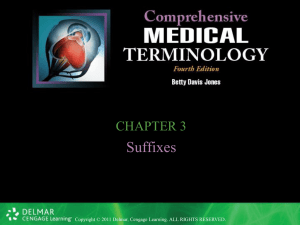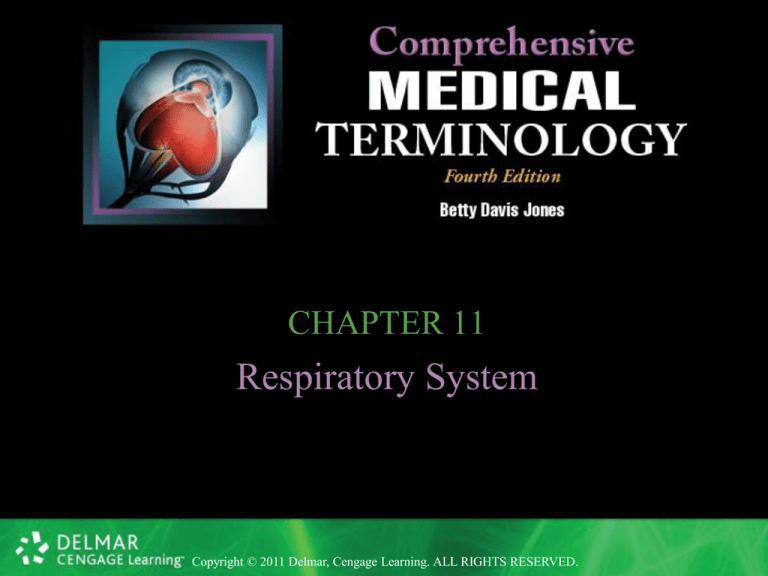
CHAPTER 11
Respiratory System
Copyright © 2011 Delmar, Cengage Learning. ALL RIGHTS RESERVED.
Respiratory System Overview
• Responsibilities of respiratory system
– Respiration = exchange of gases between body and air
• Provides oxygen to body cells for energy
• Removes carbon dioxide from body cells
– Production of sound
– Assisting in body’s defense against foreign materials
Copyright © 2011 Delmar, Cengage Learning. ALL RIGHTS RESERVED.
Respiratory System Overview
• External respiration
– Oxygen is inhaled into lungs
– Passes through capillaries of the lungs into the
pulmonary bloodstream
– Carbon dioxide passes from blood through the same
capillaries into the lungs and is exhaled
Copyright © 2011 Delmar, Cengage Learning. ALL RIGHTS RESERVED.
Respiratory System Overview
• Internal respiration
– Inhaled oxygen circulates from pulmonary bloodstream
in the lungs, back through the heart, to systemic
bloodstream, to the body cells
• At cellular level, oxygen passes through capillaries into tissue
cells where it is used for energy
• Carbon dioxide passes from tissue cells into capillaries and
travels through bloodstream for removal from body via lungs
Copyright © 2011 Delmar, Cengage Learning. ALL RIGHTS RESERVED.
Question
True or False: The purposes of the respiratory
system are respiration, producing sound, and
defending against foreign bodies.
Copyright © 2011 Delmar, Cengage Learning. ALL RIGHTS RESERVED.
Respiratory System Structures
• Nose
– External portion composed of cartilage and bone covered
with skin
• Entrance to nose = nostrils or nares (singular: naris)
• Air enters body through the nose and mouth
Copyright © 2011 Delmar, Cengage Learning. ALL RIGHTS RESERVED.
Respiratory System Structures
• Nasal cavity
– Divided into left and right chambers by dividing wall
called the septum
• As air enters through nose, it passes into the nasal cavity
Copyright © 2011 Delmar, Cengage Learning. ALL RIGHTS RESERVED.
Respiratory System Structures
• Paranasal sinuses
– Hollow areas or cavities within the skull that
communicate with the nasal cavity
– Lighten the skull and enhance the sound of the voice
– Lined with mucous membranes
• Help to warm and filter the air as it enters the respiratory system
• Cilia (hair-like projections on mucous membranes) sweep dirt
and foreign material toward throat for elimination
Copyright © 2011 Delmar, Cengage Learning. ALL RIGHTS RESERVED.
Respiratory System Structures
• Pharynx
– Airway that connects the mouth and nose to the larynx
• Also known as the throat
• Serves as a common passageway for both air and food
• Epiglottis covers opening of larynx when swallowing
Copyright © 2011 Delmar, Cengage Learning. ALL RIGHTS RESERVED.
Respiratory System Structures
• Pharynx
– Commonly divided into three sections
• Nasopharynx
– Contains the adenoids
• Oropharynx
– Contains the tonsils (palatine tonsils)
• Laryngopharynx
Copyright © 2011 Delmar, Cengage Learning. ALL RIGHTS RESERVED.
Respiratory System Structures
• Larynx
– Connects pharynx with trachea
– Also known as the voice box
– Most prominent of supporting cartilages is the thyroid
cartilage at the front
• Forms the Adam’s apple
Copyright © 2011 Delmar, Cengage Learning. ALL RIGHTS RESERVED.
Respiratory System Structures
• Larynx
– Contains structures that make vocal sounds possible –
the vocal cords
• Vocal cords vibrate as air passes through the space between
them (glottis), producing sound
Copyright © 2011 Delmar, Cengage Learning. ALL RIGHTS RESERVED.
Respiratory System Structures
• Trachea
– Extends into the chest and serves as a passageway for air
to the bronchi
– Commonly known as the windpipe
Copyright © 2011 Delmar, Cengage Learning. ALL RIGHTS RESERVED.
Respiratory System Structures
• Bronchi
– Trachea branches into two tubes called the bronchi
– Each bronchus leads to a separate lung
• Divides and subdivides into progressively smaller tubes called
bronchioles
Copyright © 2011 Delmar, Cengage Learning. ALL RIGHTS RESERVED.
Respiratory System Structures
• Bronchioles
– Smallest branches of bronchi
– Terminal ends known as alveoli
• Air sacs
• Have thin walls that allow for exchange of gases between the
lungs and the blood
• Alveoli = pulmonary parenchyma
Copyright © 2011 Delmar, Cengage Learning. ALL RIGHTS RESERVED.
Respiratory System Structures
• Lungs
– Two cone-shaped, spongy organs consisting of alveoli,
blood vessels, elastic tissue, and nerves
– Left lung has two lobes and right lung has three lobes
– Apex = uppermost part of lung
– Base = lower part of lung
– Hilum = portion in midline region where blood vessels,
nerves, and bronchial tubes enter and exit the lungs
Copyright © 2011 Delmar, Cengage Learning. ALL RIGHTS RESERVED.
Respiratory System Structures
Copyright © 2011 Delmar, Cengage Learning. ALL RIGHTS RESERVED.
Respiratory System Structures
• Pleura
– Double-folded membrane that surrounds the lungs
– Parietal pleura
• Outer layer of the pleura which lines the thoracic cavity
– Visceral pleura
• Inner layer of the pleura which covers the lungs
Copyright © 2011 Delmar, Cengage Learning. ALL RIGHTS RESERVED.
Respiratory System Structures
• Pleura
– Pleural space
• Small space between the pleural membranes
• Filled with lubricating fluid that prevents friction when the two
membranes slide against each other during respiration
Copyright © 2011 Delmar, Cengage Learning. ALL RIGHTS RESERVED.
Question
A small but very important flap covers the
larynx so that food cannot pass into the
airway during swallowing. It is called the:
a.
b.
c.
d.
adenoids
palatine tonsils
oropharynx
epiglottis
Copyright © 2011 Delmar, Cengage Learning. ALL RIGHTS RESERVED.
Breathing Process
• Inhalation = Inspiration
–
–
–
–
–
Diaphragm is stimulated by phrenic nerve
Diaphragm contracts and flattens (descends)
Chest cavity enlarges
Decrease in pressure within the thorax
Air is drawn into the lungs
Copyright © 2011 Delmar, Cengage Learning. ALL RIGHTS RESERVED.
Breathing Process
• Exhalation = Expiration
–
–
–
–
Diaphragm relaxes and rises back into thoracic cavity
Chest cavity decreases in size
Increase in pressure with the thorax
Air is forced out of lungs
Copyright © 2011 Delmar, Cengage Learning. ALL RIGHTS RESERVED.
Physical Exam Techniques
• Inspection
– Visual examination of the external surface of the body as
well as of its movements and posture
• Palpation
– Process of examining, by application of the hands or
fingers to the external surface of the body, to detect
evidence of disease or abnormalities in the various organs
Copyright © 2011 Delmar, Cengage Learning. ALL RIGHTS RESERVED.
Physical Exam Techniques
• Auscultation
– Process of listening for sounds within the body, usually
to sounds of thoracic or abdominal viscera, to detect
some abnormal condition, or to detect fetal heart sounds
• Performed with a stethoscope
Copyright © 2011 Delmar, Cengage Learning. ALL RIGHTS RESERVED.
Physical Exam Techniques
• Percussion
– Use of the fingertips to tap the body lightly but sharply to
determine position, size, and consistency of an underlying
structure and the presence of fluid or pus in a cavity
• Tapping over solid organ = dull, flat sound
• Tapping over air-filled structure = clear, hollow sound
Copyright © 2011 Delmar, Cengage Learning. ALL RIGHTS RESERVED.
Question
True or False: When the doctor listens to our
lungs in the office, he is performing
percussion.
Copyright © 2011 Delmar, Cengage Learning. ALL RIGHTS RESERVED.
Common Signs and Symptoms
• Apnea
– Temporary cessation of breathing
• “Without breathing”
• Bradypnea
– Abnormally slow breathing
– Evidenced by respiratory rate slower than 12 respirations
per minute
Copyright © 2011 Delmar, Cengage Learning. ALL RIGHTS RESERVED.
Common Signs and Symptoms
• Cough
– Forceful and sometimes violent expiratory effort
preceded by a preliminary inspiration
• Glottis is partially closed, accessory muscles of expiration
brought into action, air is noisily expelled
– Due to irritation of the airways or infection
• Irritants = dust, smoke, mucus
Copyright © 2011 Delmar, Cengage Learning. ALL RIGHTS RESERVED.
Common Signs and Symptoms
• Cough
– Nonproductive = unproductive
• Not effective in bringing up sputum
• “Dry cough”
– Productive
• Effective in bringing up sputum
• “Wet cough”
Copyright © 2011 Delmar, Cengage Learning. ALL RIGHTS RESERVED.
Common Signs and Symptoms
• Cyanosis
– Slightly bluish, grayish, slate-like, or dark purple
discoloration of the skin due to presence of abnormal
amounts of reduced hemoglobin in the blood
• Dysphonia
– Difficulty in speaking
– Hoarseness
Copyright © 2011 Delmar, Cengage Learning. ALL RIGHTS RESERVED.
Common Signs and Symptoms
• Dyspnea
– Air hunger resulting in labored or difficult breathing,
sometimes accompanied by pain
• Epistaxis
– Hemorrhage from the nose; nosebleed
Copyright © 2011 Delmar, Cengage Learning. ALL RIGHTS RESERVED.
Question
The medical term element for breathing is
_________.
a.
b.
c.
d.
–pneum
glottis
–pnea
–capnia
Copyright © 2011 Delmar, Cengage Learning. ALL RIGHTS RESERVED.
Common Signs and Symptoms
• Expectoration
– Act of spitting out saliva or coughing up materials from
the air passageways leading to the lungs
• Hemoptysis
– Expectoration of blood arising from the oral cavity,
larynx, trachea, bronchi, or lungs
Copyright © 2011 Delmar, Cengage Learning. ALL RIGHTS RESERVED.
Common Signs and Symptoms
• Hypercapnia
– Increased amount of carbon dioxide in the blood
• Hypoxemia
– Insufficient oxygenation of the blood
• Hypoxia
– Deficiency of oxygen
Copyright © 2011 Delmar, Cengage Learning. ALL RIGHTS RESERVED.
Common Signs and Symptoms
• Kussmaul respirations
– Very deep, gasping type of respiration associated with
severe diabetic acidosis
• Orthopnea
– Respiratory condition in which there is discomfort in
breathing in any but erect, sitting, or standing position
Copyright © 2011 Delmar, Cengage Learning. ALL RIGHTS RESERVED.
Common Signs and Symptoms
• Pleural rub
– Friction rub caused by inflammation of the pleural space
• Rales
– Abnormal sound heard on auscultation of the chest,
produced by passage of air through bronchi that contain
secretion or exudate or that are constricted by spasm or a
thickening of their walls
Copyright © 2011 Delmar, Cengage Learning. ALL RIGHTS RESERVED.
Common Signs and Symptoms
• Rhinorrhea
– Thin, watery discharge from the nose
• Rhonchi
– Rales or rattlings in the throat, especially when it
resembles snoring
Copyright © 2011 Delmar, Cengage Learning. ALL RIGHTS RESERVED.
Common Signs and Symptoms
• Sneeze
– To expel air forcibly through the nose and mouth by
spasmodic contraction of muscles of expiration due to
irritation of nasal mucosa
• Stridor
– Harsh sound during respiration
– High pitched and resembling the blowing of wind, due to
obstruction of air passages
Copyright © 2011 Delmar, Cengage Learning. ALL RIGHTS RESERVED.
Common Signs and Symptoms
• Tachypnea
– Abnormal rapidity of breathing
• Wheeze
– Whistling sound or sighing sound resulting from
narrowing of the lumen of a respiratory passageway
Copyright © 2011 Delmar, Cengage Learning. ALL RIGHTS RESERVED.
Question
True or False: Hypoxemia usually causes
hypoxia.
Copyright © 2011 Delmar, Cengage Learning. ALL RIGHTS RESERVED.
PATHOLOGICAL CONDITIONS
Upper Respiratory System
Copyright © 2011 Delmar, Cengage Learning. ALL RIGHTS RESERVED.
Coryza
• Pronounced
– (kor-RYE-zuh)
• Defined
– Inflammation of the respiratory mucous membranes,
known as the common cold
• “Common cold” usually refers to symptoms of an upper
respiratory tract infection
Copyright © 2011 Delmar, Cengage Learning. ALL RIGHTS RESERVED.
Croup
• Pronounced
– (KROOP)
• Defined
– Childhood disease characterized by a barking cough,
suffocative and difficult breathing, stridor, and laryngeal
spasm
Copyright © 2011 Delmar, Cengage Learning. ALL RIGHTS RESERVED.
Diphtheria
• Pronounced
– (diff-THEER-ree-uh)
• Defined
– Serious infectious disease affecting the nose, pharynx, or
larynx, usually resulting in sore throat, dysphonia, and
fever
• Caused by bacterium Corynebacterium diphtheriae, which
forms a white coating over the affected airways as it multiplies
Copyright © 2011 Delmar, Cengage Learning. ALL RIGHTS RESERVED.
Laryngitis
• Pronounced
– (lair-in-JYE-tis)
• Defined
– Inflammation of the larynx, usually resulting in
hoarseness, cough, and difficulty swallowing
• Causes: abuse of the voice, upper respiratory tract infection,
chronic bronchitis, chronic sinusitis
Copyright © 2011 Delmar, Cengage Learning. ALL RIGHTS RESERVED.
Question
Yelling too much at a ball game can cause this
condition.
a.
b.
c.
d.
stridor
laryngitis
rhinorrhea
wheeze
Copyright © 2011 Delmar, Cengage Learning. ALL RIGHTS RESERVED.
Pertussis
• Pronounced
– (per-TUH-sis)
• Defined
– Acute upper respiratory infectious disease, caused by the
bacterium Bordetello pertussis
– Also known as “whooping cough”
Copyright © 2011 Delmar, Cengage Learning. ALL RIGHTS RESERVED.
Pharyngitis
• Pronounced
– (fair-in-JYE-tis)
• Defined
– Inflammation of the pharynx, usually resulting in sore
throat
• Usually caused by a virus
Copyright © 2011 Delmar, Cengage Learning. ALL RIGHTS RESERVED.
Rhinitis
• Pronounced
– (rye-NYE-tis)
• Defined
– Inflammation of the mucous membranes of the nose
• Usually resulting in obstruction of the nasal passages,
rhinorrhea, sneezing, and facial pressure or pain
Copyright © 2011 Delmar, Cengage Learning. ALL RIGHTS RESERVED.
Sinusitis
• Pronounced
– (sigh-nus-EYE-tis)
• Defined
– Inflammation of a sinus, especially a paranasal sinus
• Usually results in pain and a feeling of pressure in the affected
sinuses
Copyright © 2011 Delmar, Cengage Learning. ALL RIGHTS RESERVED.
Tonsillitis
• Pronounced
– (ton-sill-EYE-tis)
• Defined
– Inflammation of the palatine tonsils; tonsils appear
enlarged and red with yellowish exudate
• Symptoms: sore throat, fever, snoring, difficulty swallowing
Copyright © 2011 Delmar, Cengage Learning. ALL RIGHTS RESERVED.
Question
True or False: Recurrent episodes of tonsillitis
can lead to a common procedure in children
called a pharyngectomy.
Copyright © 2011 Delmar, Cengage Learning. ALL RIGHTS RESERVED.
PATHOLOGICAL CONDITIONS
Lower Respiratory System
Copyright © 2011 Delmar, Cengage Learning. ALL RIGHTS RESERVED.
Asthma
• Pronounced
– (AZ-mah)
• Defined
– Paroxysmal dyspnea accompanied by wheezing; caused
by a spasm of the bronchial tubes or by swelling of their
mucous membrane
• Occurs most frequently in childhood or early adulthood
Copyright © 2011 Delmar, Cengage Learning. ALL RIGHTS RESERVED.
Bronchiectasis
• Pronounced
– (brong-key-EK-tah-sis)
• Defined
– Chronic dilatation of a bronchus or bronchi, with
secondary infection that usually involves the lower portion
of the lung
Copyright © 2011 Delmar, Cengage Learning. ALL RIGHTS RESERVED.
Bronchitis
• Pronounced
– (brong-KIGH-tis)
• Defined
– Inflammation of the mucous membrane of the bronchial
tubes
• Infection is often preceded by the common cold
• Patient may experience productive cough, accompanied by
wheezing, dyspnea, and chest pain
Copyright © 2011 Delmar, Cengage Learning. ALL RIGHTS RESERVED.
Bronchitis
• Acute bronchitis
– Causes are viral infection, bacterial infection, and
airborne irritants
Copyright © 2011 Delmar, Cengage Learning. ALL RIGHTS RESERVED.
Bronchitis
• Chronic bronchitis
– Primarily associated with cigarette smoking or exposure
to pollution
• Smoke irritates airways, resulting in inflammation and
hypersecretion of mucus
• Productive cough is present for at least three months of two
consecutive years
Copyright © 2011 Delmar, Cengage Learning. ALL RIGHTS RESERVED.
Bronchogenic Carcinoma
• Pronounced
– (brong-koh-JEN-ik kar-sin-OH-mah)
• Defined
– Malignant lung tumor that originates in the bronchi
– Lung cancer
Copyright © 2011 Delmar, Cengage Learning. ALL RIGHTS RESERVED.
Emphysema
• Pronounced
– (em-fih-SEE-mah)
• Defined
– Chronic pulmonary disease characterized by increase
beyond the normal in the size of air spaces distal to the
terminal bronchiole, either from dilation of the alveoli or
from destruction of their walls
• Smoking is major cause
Copyright © 2011 Delmar, Cengage Learning. ALL RIGHTS RESERVED.
Emphysema
Copyright © 2011 Delmar, Cengage Learning. ALL RIGHTS RESERVED.
Question
Which one of these conditions is NOT brought
on by smoking?
a.
b.
c.
d.
bronchiectasis
bronchogenic carcinoma
emphysema
chronic bronchitis
Copyright © 2011 Delmar, Cengage Learning. ALL RIGHTS RESERVED.
Empyema
• Pronounced
– (em-pye-EE-mah)
• Defined
– Pus in a body cavity, especially in the pleural cavity
• Usually the result of a primary infection in the lungs
Copyright © 2011 Delmar, Cengage Learning. ALL RIGHTS RESERVED.
Hyaline Membrane Disease
• Pronounced
– (HIGH-ah-lighn membrane dih-ZEEZ)
• Defined
– Severe impairment of respiration in premature newborn
– Also known as respiratory distress syndrome (RDS)
Copyright © 2011 Delmar, Cengage Learning. ALL RIGHTS RESERVED.
Influenza
• Pronounced
– (in-floo-IN-zah)
• Defined
– Highly contagious viral infection of the respiratory tract
transmitted by airborne droplet infection
– Also known as the flu
• Symptoms include sore throat, cough, fever, muscular pains, and
generalized weakness
Copyright © 2011 Delmar, Cengage Learning. ALL RIGHTS RESERVED.
Lung Abscess
• Pronounced
– (lung AB-sess)
• Defined
– Localized collection of pus formed by the destruction of
lung tissue and microorganisms by white blood cells that
have migrated to the area to fight infection
Copyright © 2011 Delmar, Cengage Learning. ALL RIGHTS RESERVED.
Pleural Effusion
• Pronounced
– (PLOO-ral eh-FYOO-zhun)
• Defined
– Accumulation of fluid in the pleural space, resulting in
compression of the underlying portion of the lung, with
resultant dyspnea
• Usually secondary to some other disease
Copyright © 2011 Delmar, Cengage Learning. ALL RIGHTS RESERVED.
Pleuritis (Pleurisy)
• Pronounced
– (ploor-EYE-tis) (PLOOR-ih-see)
• Defined
– Inflammation of both the visceral and parietal pleura
Copyright © 2011 Delmar, Cengage Learning. ALL RIGHTS RESERVED.
Question
True or False: Hyaline membrane disease only
affects premature newborns.
Copyright © 2011 Delmar, Cengage Learning. ALL RIGHTS RESERVED.
Pneumonia
• Pronounced
– (new-MOH-nee-ah)
• Defined
– Inflammation of the lungs caused primarily by bacteria,
viruses, and chemical irritants
Copyright © 2011 Delmar, Cengage Learning. ALL RIGHTS RESERVED.
Pneumothorax
• Pronounced
– (new-moh-THOH-racks)
• Defined
– Collection of air or gas in the pleural cavity
• Air enters as the result of a perforation through the chest wall or
the pleura covering the lung
Copyright © 2011 Delmar, Cengage Learning. ALL RIGHTS RESERVED.
Pulmonary Edema
• Pronounced
– (PULL-mon-air-ree eh-DEE-mah)
• Defined
– Swelling of the lungs caused by an abnormal
accumulation of fluid in the lungs, either in the alveoli or
the interstitial spaces
Copyright © 2011 Delmar, Cengage Learning. ALL RIGHTS RESERVED.
Pulmonary Embolism
• Pronounced
– (PULL-mon-air-ree EM-boh-lizm)
• Defined
– Obstruction of one or more pulmonary arteries by a
thrombus (clot) that dislodges from another location and is
carried through the venous system to the vessels of the lung
• Sudden onset
• Common symptoms: Chest pain, dyspnea, tachypnea
Copyright © 2011 Delmar, Cengage Learning. ALL RIGHTS RESERVED.
Pulmonary Heart Disease (Cor
Pulmonale)
• Pronounced
– (PULL-mon-air-ree heart dih-ZEEZ)
– (kor pull-mon-ALL-ee)
• Defined
– Hypertrophy of the right ventricle of the heart (with or
without failure) resulting from disorders of the lungs,
pulmonary vessels, or chest wall
Copyright © 2011 Delmar, Cengage Learning. ALL RIGHTS RESERVED.
Sudden Infant Death Syndrome
• Pronounced
– (sudden infant death SIN-drohm)
• Defined
– Unexpected and unexplained death of an apparently
well, or virtually well, infant
– Also known as crib death or SIDS
Copyright © 2011 Delmar, Cengage Learning. ALL RIGHTS RESERVED.
Tuberculosis
• Pronounced
– (too-ber-kyoo-LOH-sis)
• Defined
– Infectious disease caused by the tubercle bacillus,
Mycobacterium tuberculosis
– Inflammatory infiltrations, formation of tubercles, and
caseous (cheese-like) necrosis in the tissues of the lungs
Copyright © 2011 Delmar, Cengage Learning. ALL RIGHTS RESERVED.
Question
Pulmonary embolism is caused by thrombus
(clot). In the cardiovascular system, which
term was mentioned that could be the source?
a.
b.
c.
d.
varicose veins
patent ductus arteriosus
aneurysm
deep vein thrombosis
Copyright © 2011 Delmar, Cengage Learning. ALL RIGHTS RESERVED.
PATHOLOGICAL CONDITIONS
Work-Related
Copyright © 2011 Delmar, Cengage Learning. ALL RIGHTS RESERVED.
Anthracosis
• Pronounced
– (an-thrah-KOH-sis)
• Defined
– Accumulation of carbon deposits in the lungs due to
breathing smoke or coal dust
– Also known as black lung disease or coal worker’s
pneumonoconiosis
Copyright © 2011 Delmar, Cengage Learning. ALL RIGHTS RESERVED.
Asbestosis
• Pronounced
– (as-beh-STOH-sis)
• Defined
– Lung disease resulting from inhalation of asbestos
particles
Copyright © 2011 Delmar, Cengage Learning. ALL RIGHTS RESERVED.
Byssinosis
• Pronounced
– (bis-ih-NOH-sis)
• Defined
– Lung disease resulting from inhalation of cotton, flax,
and hemp
• Bleached cotton not a threat
– Also known as brown lung disease
Copyright © 2011 Delmar, Cengage Learning. ALL RIGHTS RESERVED.
Silicosis
• Pronounced
– (sill-ih-KOH-sis)
• Defined
– Lung disease resulting from inhalation of silica (quartz)
dust
– Characterized by formation of small nodules
Copyright © 2011 Delmar, Cengage Learning. ALL RIGHTS RESERVED.
Question
True or False: Byssinosis is also called black
lung disease.
Copyright © 2011 Delmar, Cengage Learning. ALL RIGHTS RESERVED.
DIAGNOSTIC TECHNIQUES, TREATMENTS,
AND PROCEDURES
Respiratory System
Copyright © 2011 Delmar, Cengage Learning. ALL RIGHTS RESERVED.
Diagnostic Techniques, Treatments,
and Procedures
• Bronchoscopy
– Examination of interior of bronchi using a lighted,
flexible bronchoscope (or endoscope)
• Chest X-ray
– High-energy electromagnetic waves passing through the
body onto a photographic film
– Produces a picture of the internal structures of the body
for diagnosis and therapy
Copyright © 2011 Delmar, Cengage Learning. ALL RIGHTS RESERVED.
Diagnostic Techniques, Treatments,
and Procedures
• Laryngoscopy
– Examination of interior of the larynx using a lighted,
flexible tube known as a laryngoscope (or endoscope)
• Lung scan
– Visual imaging of the distribution of ventilation or blood
flow in the lungs by scanning the lungs after the patient
has been injected with or has inhaled radioactive material
Copyright © 2011 Delmar, Cengage Learning. ALL RIGHTS RESERVED.
Diagnostic Techniques, Treatments,
and Procedures
• Pulmonary function tests
– Variety of tests performed to assess respiratory function
• Sputum specimen
– Specimen of material expectorated from the mouth
• If produced after a cough, it may contain, in addition to saliva,
material from the throat and bronchi
Copyright © 2011 Delmar, Cengage Learning. ALL RIGHTS RESERVED.
Diagnostic Techniques, Treatments,
and Procedures
• Thoracentesis
– Procedure that involves the use of a needle to collect
pleural fluid for laboratory analysis, or to remove excess
pleural fluid or air from the pleural space
Copyright © 2011 Delmar, Cengage Learning. ALL RIGHTS RESERVED.
Diagnostic Techniques, Treatments,
and Procedures
Copyright © 2011 Delmar, Cengage Learning. ALL RIGHTS RESERVED.
Diagnostic Techniques, Treatments,
and Procedures
• Tonsillectomy
– Surgical removal of the palatine tonsils
• Usually combined with an adenoidectomy (surgical removal of
adenoids)
Copyright © 2011 Delmar, Cengage Learning. ALL RIGHTS RESERVED.
Diagnostic Techniques, Treatments,
and Procedures
• Tuberculin skin test (TST)
– Determines past or present tuberculosis infection present
in the body
• Based on positive skin reaction to the introduction of a purified
protein derivative (PPD) of the tubercula bacilli into the skin
Copyright © 2011 Delmar, Cengage Learning. ALL RIGHTS RESERVED.
Question
A patient is found to have a large amount of
fluid in the pleural cavity. A _____________
is performed to relieve the patient's
respiratory distress.
a.
b.
c.
d.
chest x-ray
bronchoscopy
pulmonary function test
thoracentesis
Copyright © 2011 Delmar, Cengage Learning. ALL RIGHTS RESERVED.

